The term off-ground tents describes shelters that are physically elevated, they are above ground so they are not in contact with the ground at all. The most important and typical types are described in detail here.
There are several very different types of off-ground tents and shelters, and they include the following:
- Cot-tents.
- Roof top tents.
- Hammock tents.
- Freestanding hammock tents.
- Truck tents.
The group of roof top tents includes a variety of types that can be attached on a car, on a truck, on a van, on a SUV etc.
Cot-tents
These are sometimes also called tent-cots, though for some people this may imply just cots used in tents. So I would rather use the phrase cot-tent or write it as ‘cot tent’.
But the meaning of both phrases should be the same. It means that you have a tent attached to a cot which serves as a platform that elevates the tent above ground. One great example of such shelters is shown in the picture below, the Kamp-Rite Oversize Tent Cot.
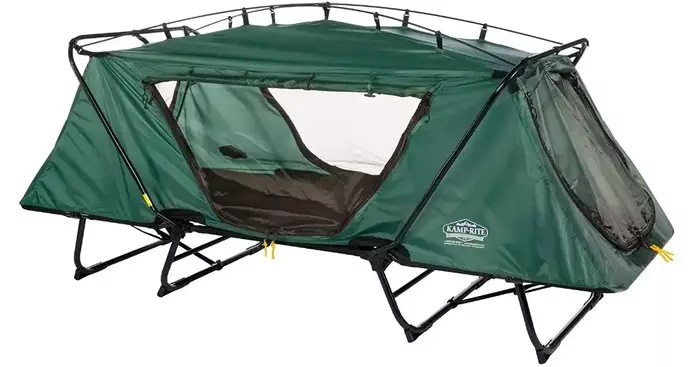
In other words, with such a shelter you have at least two items, a bed (cot), and a cover (tent) that protects you from the elements and from insects. Sometimes you may also have a mattress included in the package.
Cot-tents are built both as solo shelters and as shelters for two users. I have never seen a three-person cot-tents on the market.
The video below shows the mentioned cot-tent that has been around for many years already:
Advantages of cot-tents
Here, and also further in the text, I speak about advantages compared to the other types of off-ground shelters, so this is not relative to standard ground tents.
- You can place a cot-tent literally anywhere, so the type of ground does not play any role. The bed is always at some distance from the ground and you are safe from moisture and dirt.
- Some of them are low profile, and the cover is aerodynamic, so they can perform well even in very windy conditions.
- There are folding designs that need no assembly so you can have both the bed and shelter ready in seconds.
- There are backpack-portable ultralight cot-tents that are suitable even for the trail.
- These are usually very affordable outdoor sleeping options.
- Compared to roof tents, you are closer to the ground, so this makes life easier during the night when the nature calls.
Disadvantages of cot-tents
This is again only in comparison with the other off-ground sleeping options. So here are some:
- You may be in a situation that you have to sleep at a place where it is not convenient or even not allowed to set the cot-tent up and spend the night.
- Limited capacity. This means they are mostly solo shelters and maximum for two users.
Roof top tents
This is the largest group here in terms of types and sub-types, designs, and shapes. Did you know that these tent have been around from 1937 or so?
There are generally two main types of roof top tents:
- Hard shell roof top tents.
- Soft shell roof top tents.
Hard shell roof top tents
The term hard shell implies that you have a solid container. This can be a solid bottom and a solid lid, but some models are bottomless. There are two sub-types here, and they include:
- Pop-up roof top tents.
- Clam shell roof top tents.
The pop-up hard top tents have an integrated system that lifts the roof almost by itself. So you have a solid roof and the sides are a fabric. Below you can see the Roam Rambler pop-up hard shell roof top tent which belongs to this group:
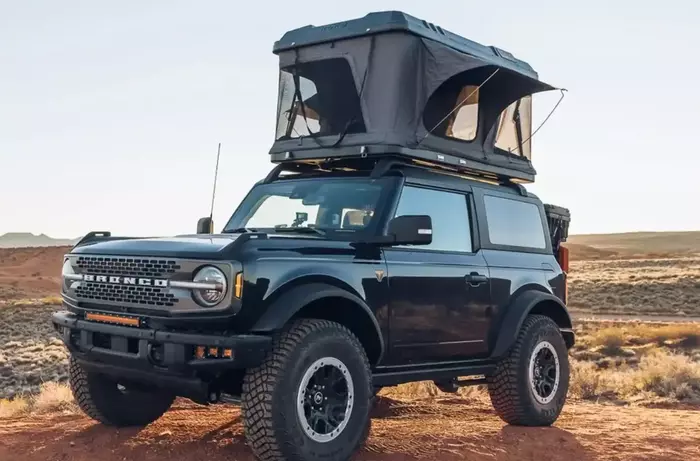
The clam shell type is a design where the lid opens to the side. They can be both expandable and non-expandable. The meaning is that the floor size is either determined by the bottom of the box, or it can be expanded.
The picture below shows the Freespirit Recreation Aspen clamshell roof top tent as one great example on non-expandable models.
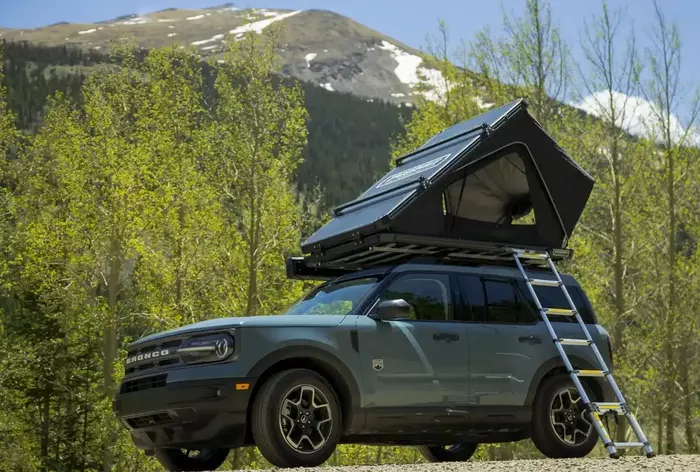
Soft shell roof top tents
This type of roof top tent is probably the most popular, together with the clamshell type described above. Here you have a tent that folds and unfolds easily, and you can have it ready in a minute or two.
They always come with a ladder that packs together with the shelter, but your sleeping gear remains separate. One good feature of these shelters is that many of them expand so that they create an awning which creates a dry entry. This is never so with pop-up roof top tents.
Many of brands also provide accessory shade/annex that you can attach to the extended awning, so you can create a space that is fully protected from the rain, and you also have a full privacy inside. The picture below shows one great example of that type, the Thule Tepui Explorer Autana 3 with Annex.
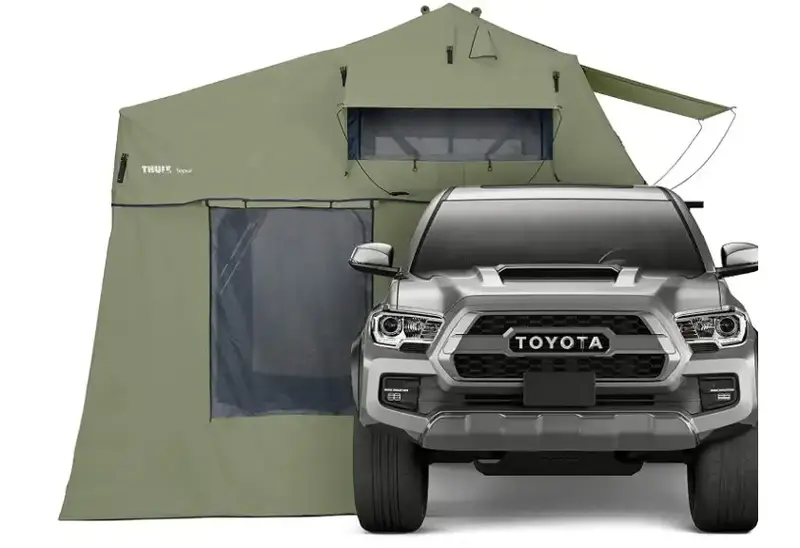
Capacity of roof top tents
The term capacity may imply sleeping capacity and weight capacity.
- Regarding the sleeping capacity, you have them in the range 1-6 people. Currently, the largest roof top tents are inflatable type. See one in the picture below, this is the GentleTent GT Sky Loft inflatable soft shell roof top tent.
- The term weight capacity is about static weight that the base of the roof top tent can support. This is always clearly indicated in specifications. So for example, a roof top tent with the capacity of 3-6 people will probably not be strong enough to accommodate three heaviest sumo wrestlers.
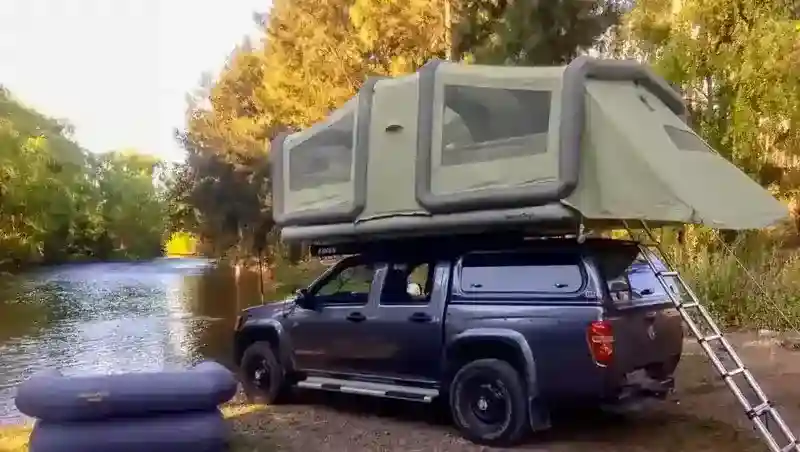
Advantages of roof top tents
- Compared to other types of off-ground shelters, you do not need extra space to set up your shelter. So when you park your car, you can sleep in it almost anywhere where you can get with your car.
- Roof top tents of any type are very easy to use. The easiest to use are hardshell roof top tents. This is because your sleeping stuff (a mattress, a pillow, a blanket) remains inside of the box. This is not so with any other off-ground shelter presented here.
- In some of them all your sleeping equipment is always ready. This means you have more space in the car.
- You are far from the ground and much better protected from ticks, scorpions, spiders, and snakes. This applies also to larger wildlife, and you are generally safer on the roof.
- Inner comfort is better than in any other off-ground shelter. But you can make life comfortable also in truck tents.
Disadvantages of roof top tents
- Roof top tents are the most expensive outdoor shelters. So if you are on a budget, better check some other options here in the site.
- A roof tent is usually very boxy and high above the ground, so this is not an optimal choice for very windy places.
- Roof top tent is only for places with your vehicle access. Compare this with ultralight cot-tents that you can use even on the trail and carry in the pack.
- Roof top tents are an item on the car, so this affects fuel efficiency and speed of the car.
- There may be issues of height and clearance when you want to park the car under low hanging tree branches, or when you want to get into some enclosed and low space like a garage.
- Roof top tents accessibility may be an issue for elderly users, and also for people with mobility issues. You realize that you get in and out by using a ladder.
Hammock tents
A hammock tent includes a hanging hammock and some sort of cover for rain protection. You may also have a fully enclosed design with protection against flying insects and ticks as well.
There are not so many of them on the market, and they are not suitable for every sort of sleepers. If you sleep on the stomach or on the side, this shelter is definitely not for you.
But if you are a back sleeper and a hunter or a backpacker, and your activity is in forested areas, this is something to consider.
The picture below shows an excellent example, this is the Crua Hybrid where you have a hammock and a tent in one. The word Hybrid in the name means that you can use it also as a ground tent.
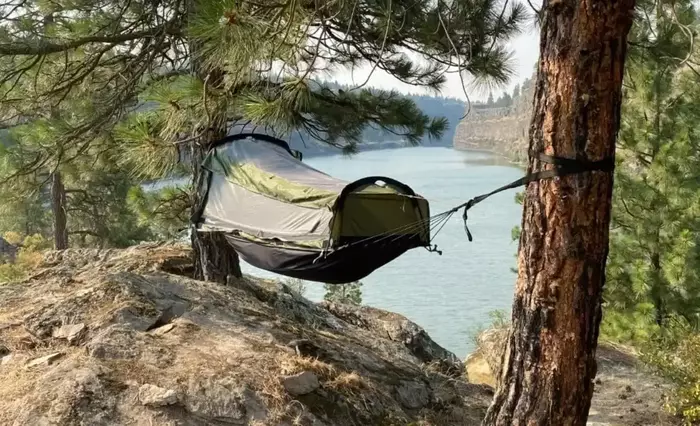
In this video you can see more about this unique shelter:
Advantages of hammock tents
- These shelters are among the lightest here in the list, so they can be backpack portable.
- They are also among the most compact off-ground shelters.
- They are usually less expensive than most of off-ground shelters.
- Usually, you have a great ventilation in such a shelter. They are less stuffy than roof top tents and cot-tents.
- They are versatile. This is based on their weight, packed size, and ease of use. So you can use them for a variety of outdoor activities like hiking, backpacking, cycling, kayaking, hunting, camping, etc.
- They do not impact vegetation on the ground.
Disadvantages of hammock tents
- You need trees to use this shelter. So they are useless above the tree line, but you have seen one great exception above.
- The design is suitable mainly for back sleepers.
- Limited space as compared to some other off-ground shelters discussed here.
- It may be more difficult to remain warm in a cold environment.
Freestanding hammock tents
This type is quite rare on the market. There are freestanding hammocks, but those that also include a rain cover are rare. They are designed so that you do not depend on trees, and in principle you can use them anywhere. The picture shows one of them, the ENO Nomad Shelter System.
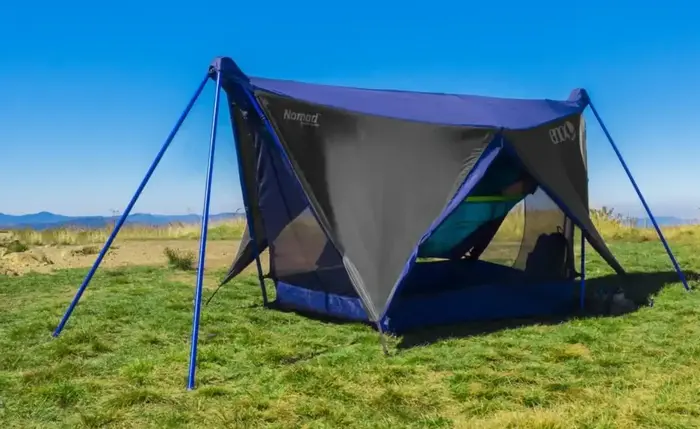
Advantages of freestanding hammock tents
- When compared to standard hammock tents, they are far more versatile. You do not need trees.
- They offer more comfort than standard hammock tents. This is partly because they may have spreader bars so the bed is more similar to a cot than to a classic hammock.
- They have a frame with a variety of storage options for your personal items, clothing, shoes, etc.
- They are far less expensive than roof top tents. Some of them are more or less in the rank of cot-tents.
- Because of the frame and when they have spreader bars, they are far more stable than hammock tents.
Disadvantages of freestanding hammock tents
- The freestanding hammock tents are for car camping only. In this sense they are not even in the rank of cot-tents that can be backpack portable.
- They are practically always for a solo use. Compare this to cot-tents that can be for two people as well.
- They are less comfortable than cot-tents.
- They are not suitable for harsh weather conditions.
- They are mainly for back sleepers.
Truck tents
This type can sometimes be mixed with roof top tents. The reason is that roof top tents can also be used on a truck.
But the term truck tents here describes shelters that are very similar to standard ground tents, they just may have some extra features that are added so that they fit on a truck.
Below you can see one incredibly popular example, the Napier Backroadz Truck Tent, you can describe it as an ordinary tent adapted to fit the space of a truck.
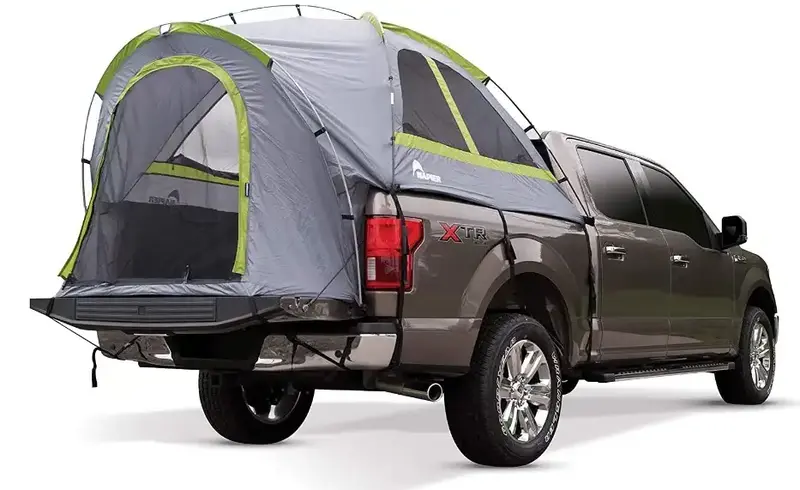
Advantages of truck tents
- These shelters are usually very affordable, no much difference as compared to standard ground tents.
- As you realize from the example shown above, although you are elevated, you are far lower that in the case of a roof top tent. So it is easier to get in an out.
- They are designed for trucks, so this implies they are more suitable for off-road use simply because you can usually get to more remote areas with a truck than with a car.
- You may have more options regarding choosing the bed that you use, and also regarding the mattress. This is not so with the roof top tents and cot-tents.
- They may be much taller than roof top tents and cot tents.
Disadvantages of truck tents
- Similar to roof top tents, these shelters are designed for trucks, so you can use the only at places with truck access.
- They need assembly similar to ground tents.
- Compared to roof top tents, here you can expect far more issues related to compatibility. You have to know the precise measures of both the truck and the tent, and also the features of the truck tent.
So these are all basic types of off-ground tents and shelters that are currently on the market. You have plenty of their representatives described here in the site. If some other designs appear on the market, this text will be updated.
So bookmark this text and site and have as a reference, this will keep you infirmed. Thank you for reading.


Thank you for this insightful post. The way you presented the information made it easy to understand and apply. I appreciate the effort you put into researching and writing this. It’s a great resource for anyone looking to learn more about this subject.
Most welcome.